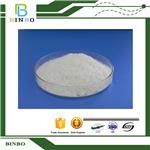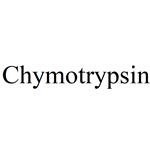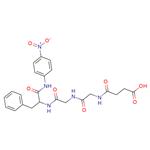Degradation
The rate and extent of insulin degradation by trypsin and α-Chymotrypsin were examined in vitro, and the initial sites of cleavage by α-Chymotrypsin were identified. The apparent Km for both enzymes was approximately the same, but the apparent Vmax for α-Chymotrypsin was 8.6 times greater. At a molar ratio of 172:1 (insulin: enzyme), chymotrypsin caused near-total loss of insulin within 40 min, while very little insulin was degraded by trypsin. Chymotrypsin appeared to cleave initially at the carboxyl side of the B26-Tyr and A19-Tyr residues, and additional cleavage at the B16-Tyr, B25-Phe, and A14-Tyr residue sites also occurred rapidly. Only two to three other susceptible bonds, which are not exposed at the surface of the insulin molecule, remained intact after the quenching of initial cleavage[1].
Chemical Properties
Lyophilized powder, dialyzed
Uses
The enzyme from Sigma has been used to assess the effect of limited proteolysis with α-chymotrypsin on the sperm penetration.
Uses
α-Chymotrypsin from bovine pancreas has been used in a study to investigate protein extraction by Winsor-III microemulsion systems. α-Chymotrypsin from bovine pancreas has also been used in a study to investigate a new specific fullerene-based fluorescent probe for trypsin.
Uses
α-Chymotrypsin from bovine has been used in a study to inform proteasome inhibition in order to advance anticancer research. α-Chymotrypsin from bovine has also been used in a study that functionalized surface anchored poly(methylhydrosiloxane) thin films on oxidized silicon wafers.
General Description
Chymotrypsin (Chymar) is extractedfrom mammalian pancreas and is used in cataractsurgery. A dilute solution is used to irrigate the posteriorchamber of the eye to dissolve the fine filaments that holdthe lens.
Biochem/physiol Actions
α-Chymotrypsin is a serine peptidase and has 241 amino acid residues contained in three polypeptide chains (A chain-13 residues, B chain-131 residues, and C chain-97 residues) linked by disulfide bridges. Molecular weight of this enzyme is found to be 25 kDa. Its pI is 8.75. It selectively hydrolyzes peptide bonds on the C-terminal side of tyrosine, phenylalanine, tryptophan, and leucine. Ca2+ activates and stabilizes the enzyme. The enzyme is inhibited by diisopropyl fluorophosphate (DFP), phenylmethanesulfonyl fluoride (PMSF), N-p-tosyl-L-phenylalanine chloromethyl ketone (TPCK), chymostatin, aprotinin, α1-antitrypsin, α2-macroglobulin, 10 mM Cu2+ and Hg2+.
Mechanism of action
The general mechanism for chymotrypsin is the classic serine protease mechanism. Hydrolytic proteolysis by α-chymotrypsin begins with an initial nucleophilic attack on the peptide bond by Ser 195, activated by deprotonation by His 57. This leads to forming a tetrahedral intermediate, stabilized by the amide groups of Ser 195 and Gly 193. The subsequent collapse of this intermediate, assisted by protonation of the leaving group by His 57 and Asp 102, leads to an acyl-enzyme intermediate. Activation of a water molecule by His 57 and Asp 102 facilitates hydrolysis of this intermediate, resulting in the reformation of the catalytically active serine residue and the release of the product facilitated by protonation with His 57.
Purification Methods
α-Chymotrypsin is crystallised twice from four-tenths saturated ammonium sulfate solution, then dissolved in 1mM HCl and dialysed against 1mM HCl at 2-4o. The solution is stored at 2o [Lang et al. J Am Chem Soc 80 4923 1958].
References
[1] R J Schilling, A K Mitra. “Degradation of insulin by trypsin and alpha-chymotrypsin.” Pharmaceutical Research 8 6 (1991): 721–7.




